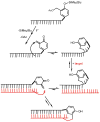Inducible alkylation of DNA by a quinone methide-peptide nucleic acid conjugate
- PMID: 22243337
- PMCID: PMC3277674
- DOI: 10.1021/bi201492b
Inducible alkylation of DNA by a quinone methide-peptide nucleic acid conjugate
Abstract
The reversibility of alkylation by a quinone methide intermediate (QM) avoids the irreversible consumption that plagues most reagents based on covalent chemistry and allows for site specific reaction that is controlled by the thermodynamics rather than kinetics of target association. This characteristic was originally examined with an oligonucleotide QM conjugate, but broad application depends on alternative derivatives that are compatible with a cellular environment. Now, a peptide nucleic acid (PNA) derivative has been constructed and shown to exhibit an equivalent ability to delivery the reactive QM in a controlled manner. This new conjugate demonstrates high selectivity for a complementary sequence of DNA even when challenged with an alternative sequence containing a single T/T mismatch. Alternatively, alkylation of noncomplementary sequences is only possible when a template strand is present to colocalize the conjugate and its target. For efficient alkylation in this example, a single-stranded region of the target is required adjacent to the QM conjugate. Most importantly, the intrastrand self-adducts formed between the PNA and its attached QM remained active and reversible over more than 8 days in aqueous solution prior to reaction with a chosen target added subsequently.
Figures









Similar articles
-
Time-dependent evolution of adducts formed between deoxynucleosides and a model quinone methide.Chem Res Toxicol. 2005 Sep;18(9):1364-70. doi: 10.1021/tx0501583. Chem Res Toxicol. 2005. PMID: 16167827
-
Few constraints limit the design of quinone methide-oligonucleotide self-adducts for directing DNA alkylation.Chem Commun (Camb). 2011 Feb 7;47(5):1476-8. doi: 10.1039/c0cc03317k. Epub 2010 Nov 18. Chem Commun (Camb). 2011. PMID: 21088763 Free PMC article.
-
Conjugation of a hairpin pyrrole-imidazole polyamide to a quinone methide for control of DNA cross-linking.Bioconjug Chem. 2004 Jul-Aug;15(4):915-22. doi: 10.1021/bc049941h. Bioconjug Chem. 2004. PMID: 15264882
-
Quinone methide derivatives: important intermediates to DNA alkylating and DNA cross-linking actions.Curr Med Chem. 2005;12(24):2893-913. doi: 10.2174/092986705774454724. Curr Med Chem. 2005. PMID: 16305478 Review.
-
Targeting double stranded DNA with peptide nucleic acid (PNA).Curr Med Chem. 2001 Apr;8(5):545-50. doi: 10.2174/0929867003373373. Curr Med Chem. 2001. PMID: 11281841 Review.
Cited by
-
Synthesis of peptide nucleic acids containing a crosslinking agent and evaluation of their reactivities.Molecules. 2015 Mar 13;20(3):4708-19. doi: 10.3390/molecules20034708. Molecules. 2015. PMID: 25781072 Free PMC article.
-
Crosslinking reactions of 4-amino-6-oxo-2-vinylpyrimidine with guanine derivatives and structural analysis of the adducts.Nucleic Acids Res. 2015 Sep 18;43(16):7717-30. doi: 10.1093/nar/gkv797. Epub 2015 Aug 5. Nucleic Acids Res. 2015. PMID: 26245348 Free PMC article.
-
Experimental approaches to identify cellular G-quadruplex structures and functions.Methods. 2012 May;57(1):84-92. doi: 10.1016/j.ymeth.2012.01.008. Epub 2012 Feb 11. Methods. 2012. PMID: 22343041 Free PMC article.
-
Efforts toward treatments against aging of organophosphorus-inhibited acetylcholinesterase.Ann N Y Acad Sci. 2016 Jun;1374(1):94-104. doi: 10.1111/nyas.13124. Epub 2016 Jun 21. Ann N Y Acad Sci. 2016. PMID: 27327269 Free PMC article. Review.
-
Photouncaged Sequence-specific Interstrand DNA Cross-Linking with Photolabile 4-oxo-enal-modified Oligonucleotides.Sci Rep. 2015 May 28;5:10473. doi: 10.1038/srep10473. Sci Rep. 2015. PMID: 26020694 Free PMC article.
References
-
- Kean JM, Miller PS. Effect of target structure on cross-linking by psoralen-derivatized oligonucleoside methylphosphonates. Biochemistry. 1994;33:9178–9186. - PubMed
-
- Kim KH, Nielsen PE, Glazer PM. Site-specific gene modification by PNAs conjugate to psoralen. Biochemistry. 2006;45:314–323. - PubMed
-
- Warpehoski MA, Hurley LH. Sequence selectivity of DNA covalent modification. Chem Res Toxicol. 1988;1:315–333. - PubMed
Publication types
MeSH terms
Substances
Grants and funding
LinkOut - more resources
Full Text Sources

